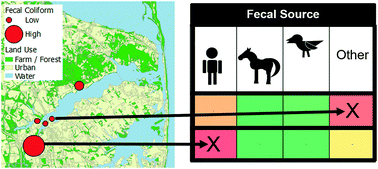Comparison of qPCR and amplicon sequencing based methods for fecal source tracking in a mixed land use estuarine watershed†
Abstract
Fecal indicator bacteria are commonly used to evaluate water quality and make decisions on designating and restricting use. A drawback of this method is that it does not differentiate fecal sources for management purposes. Here, qPCR for human and horse fecal markers and amplicon sequencing were performed in parallel with cultivation of fecal coliform in the Navesink River, a mixed land use estuarine watershed in New Jersey. A fecal library was created by mixing water from the Navesink River with municipal wastewater and/or horse manure, dog feces, or goose feces. Then, river water samples were collected during wet and dry weather from various locations with differing primary land use. Three methods for interpretation of the amplicon sequencing data for source tracking were considered: ordination-based statistics, identification of biomarkers with linear discriminant analysis, and application of the Bayesian statistics based SourceTracker program using a previously published Australian fecal library. Among these, biomarkers performed well for dog feces and SourceTracker performed well for assigning goose feces to avian sources and horse manure to horse sources and moderately well for human/sewage fecal assignments in the Navesink library. Based upon these results, fecal assignments were made using the sequencing data for the Navesink River samples with elevated fecal coliform and these results were compared to qPCR, historical source tracking reports for the watershed, and land use data. Horse, human feces/sewage, and avian feces were implicated as potential fecal sources in the polluted waters. Recommendations for future source tracking studies with amplicon sequencing are provided.



 Please wait while we load your content...
Please wait while we load your content...